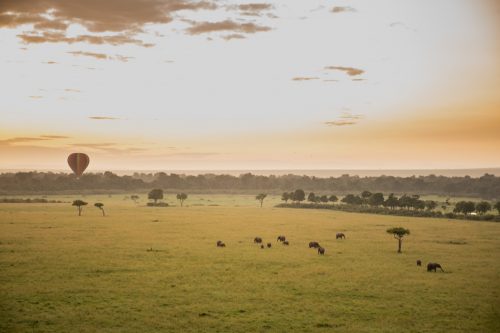Safari is normally unpredictable, once you embark on the adventure, the thrill lies in not knowing what to expect. That uncertainty adds an extra layer of excitement to the experience. As we marvelled at the dusty plains of Amboseli National Park, Amgama Amboseli Guide, Salaash, suddenly pointed out not one but two spotted cats in the distance.
Approaching closer, it became evident that two male cheetahs were up to something intriguing. These magnificent creatures, the fastest on land, strode grandly across the plains, charming us with their beauty. Judging by the emptiness of their bellies, it was clear they needed to feed so we eagerly lingered in the hope of witnessing a hunt; perhaps targeting nearby impalas. However, as the heat became unbearable, the cheetahs chose to cool off under a nearby log.
Not long after, they resumed their journey, this time heading further away from us. So, we decided to let them be, hopeful that they would find a meal for the day.
The Amboseli ecosystem boasts a rich variety of avian species and the squacco heron is a standout with its vivid colours. These migratory birds breed in southern Europe and make their way to sub-Saharan Africa, where they can be found in Kenya and other parts of East Africa. Thriving in diverse wetland environments, squacco herons are a common sight in Amboseli.
These elegant birds feed on large insects like grasshoppers and beetles, but their culinary preferences extend to amphibians like frogs and various species of fish. Their striking presence and vibrant behaviours make Amboseli a captivating destination for bird enthusiasts, offering a constant display of nature's wonders.
Back at Kimana Sanctuary, as the rains continue to nourish the landscape, the gentle giants are now also enjoying the tranquillity that is Angama Amboseli. We have spotted several of them strolling between Guest Suites and even indulging in the lush grass on the front lawn. This Sanctuary provides a safe haven for these magnificent creatures, allowing them to thrive and propagate, creating a heartwarming sight for all who visit. — Sammy Njoroge
The Maasai Mara grasslands are home to a myriad of fascinating creatures, each contributing to the rich tapestry of biodiversity. Among these, is the black-bellied bustard, which is characterised by its distinctive brown and black plumage. The males engage in elaborate courtship displays to attract females — these include impressive visuals and vocal components, showcasing the bird's ability to maintain territories.
In the wild, it's not only the animals that are often seen as prey that need to fight for survival; predators are in constant competition and often conflict with one another. In the Mara, we are privileged to have quite a sizeable number of cheetahs but they are still threatened due to the high density of larger predators like lions, leopards and hyenas — all of which compete with cheetahs for prey and, given the opportunity, they may even prey on cheetahs.
We've had quite a few sightings of a new lone male from the Serengeti, known as Olotii, who seems to come and go from the Mara Triangle as he likes. We don't get to see him often, but it's always a treat when we do. We would love to see a lot more of him so we hope he treads with a lot of care as he is surrounded by many predators, especially lions.
Often regarded as shy, nocturnal animals, leopards have been thriving in the Mara Triangle. We have seen the leopard population rapidly increasing, including a yet-to-be-identified leopard with two cubs around Little Governor's Camp. The mother of the cubs will hide the cubs within her territory; where she will pick anything from dense stands of vegetation, narrow gullies along a dry watercourse and even inside old, inactive termite mounds. This week, we watched as the cubs carefully followed their mother's lead climbing up and down a tree. — Joseph Njenga
Filed under: This Week at Angama
Subscribe for Weekly Stories
Comments (0):

Hot-air Ballooning